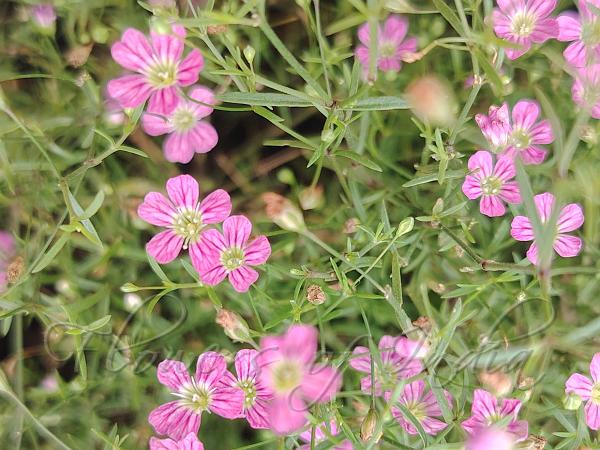|
| Low Baby's-Breath |
|

|

| File size | 657129 |
| Original date | 7/23/24 8:31 AM |
| Resolution | 1760 x 1320 |
| Flash | Flash did not fire, auto |
| Focal length | 5.25mm |
| Exposure time | 1/100s |
| Aperture | 1.75 |
| Focus Distance | |
| Metering Mode | Center weighted average |
| Camera make | HONOR |
| Camera model | ALI-NX1 |
| Sensor type | OneChipColorArea |
|
|
|
|
Photo: |
Botanical name: Psammophiliella muralis Family: Caryophyllaceae (Carnation family)
Synonyms: Gypsophila muralis, Gypsophila arvensis, Gypsophila serotina
Synonyms: Gypsophila muralis, Gypsophila arvensis, Gypsophila serotina
Low Baby's-Breath is an erect herb, recognized by its
numerous tiny, delicate 5-petaled flowers, tubular sepal-cup with a
green and white striped appearance, opposite linear leaves, forking
branches, and snail-shell-shaped seeds. Flowers are single at the tips
of branching stems and arising on slender stalks from upper leaf axils.
Flowers are 0.6-1 cm across with 5 light pink to lavender petals with
darker streaks, fused at the base into a slender tube. Inside the tube
are 10 white stamens and a split style. The sepal-cup is about 3 mm
long with 5 triangular sepals about half as long as the petals. Sepals
are green with white edging that extends nearly to the base of the
sepal-cup, giving a green and white striped look. Flower stalks are
slender and up to 2 cm long. All parts are hairless. This robust plant
has hundreds of flowers. Leaves are opposite, lance-linear, pointed at
the tip, stalkless at the base, toothless, hairless, the lower leaves
up to 2.5 cm long, less than 3 mm wide, becoming smaller as they ascend
the stem. Stems are slender, heavily branched throughout with forking
branches, sparsely and minutely hairy near the base and hairless above.
Low Baby's-Breath is native to Europe to Siberia and W. Himalaya. It is
cultivated as a garden plant in cooler parts of India.
| Identification credit: Tabish | Photographed in Mao, Manipur. |
• Is this flower misidentified? If yes,